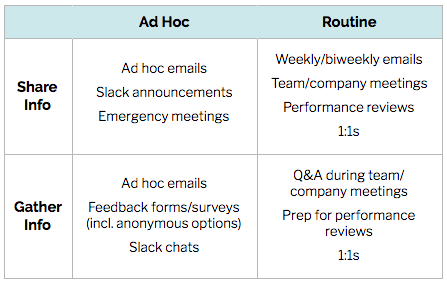Acknowledging When You Mess Up
We all mess up sometimes.
And when you’re a manager, your mistakes can have major ripple effects: people will repeat inaccurate or incomplete information you shared with them, teammates may feel slighted but not safe telling you or correcting you, project plans can be jeopardized because someone with power (you!) got a name/date/critical piece of info wrong.
If you’re lucky, you’ll realize that you’ve messed up. So what do you do, when you have that sudden realization that you need to both acknowledge your mistake, and speedily correct it to stop (or at least slow down) those ripple effects?
Acknowledge your mistake
I shared this tip at Write/Speak/Code recently, which they tweeted! Coach and trainer Paloma Medina taught me the importance of repeating the following message as a leader when you realize your (or your organization’s) mistake:
“I see now that when [thing] happened, we messed up with [this]. What if next time, we instead try [that]?”
Use multiple communication channels
You likely have a range of places in which you can push and pull information from those around you; do you know what they all are?
Here’s an example catalog of one manager’s ad hoc and routine communication channels:

Your channels might be totally different, based on your own style, your team’s routines, and your company’s avenues for communication. It’s important to know take inventory of all of the communication mediums available to you, so that when you need to communicate something important (like correcting a mistake you’ve made), you already know where to go.
Your teammates will probably be waiting expectantly for you to acknowledge your mistake and clear the air. And more often than not, they’ve already cataloged your different communication mediums! I often hear folks say things like, “I hope Leader talks about XYZ Problem in the next All Hands,” or “Welp, there goes another 1:1 in which my manager didn’t address this big issue with me,” or “It’s been 3 weeks since they last emailed about this messy project.” Start to figure out where your teammates anticipate follow-ups on announcements, launches, recognition/rewards, etc.
Read on for more about how to leverage those communication channels!
Comms Plan (Tick Tock Doc)
Get familiar with the art of a communication plan: your step-by-step plan that you and others will follow to communicate news throughout your organization. Deepa Subramaniam, my partner in crime at Wherewithall, called this a “tick tock doc”, which I love. Share a document with whomever else is doing the heavy lifting of communicating, and include in a table that includes the following for each communication step:
- Date/time
- Who is doing the comms
- Medium (meeting? email? other?)
- Talking points for this step
Create a row for each and every step; cover the different communication channels and how the talking points will evolve each time as more people are clued in.
Week in Review Emails
At the end of July, I published a template for “Week in Review” emails. Routinely sending a Week in Review can help you set records straight, disseminate info to lots of people at once, and open up conversation internally, while reflecting on the themes that have come up in weekly one-on-ones, backchannels, team meetings, etc.
Don’t just drop a few bullet points of topics in there—share your broader context! Reference the themes you’re hearing in one-on-ones, and outline next steps when ambiguity remains. Just dump buckets of context and clarity in there, and include an estimated date of when you’ll deliver more context or clarity next.
 New: The Complete Demystifying Management Video Program
New: The Complete Demystifying Management Video Program